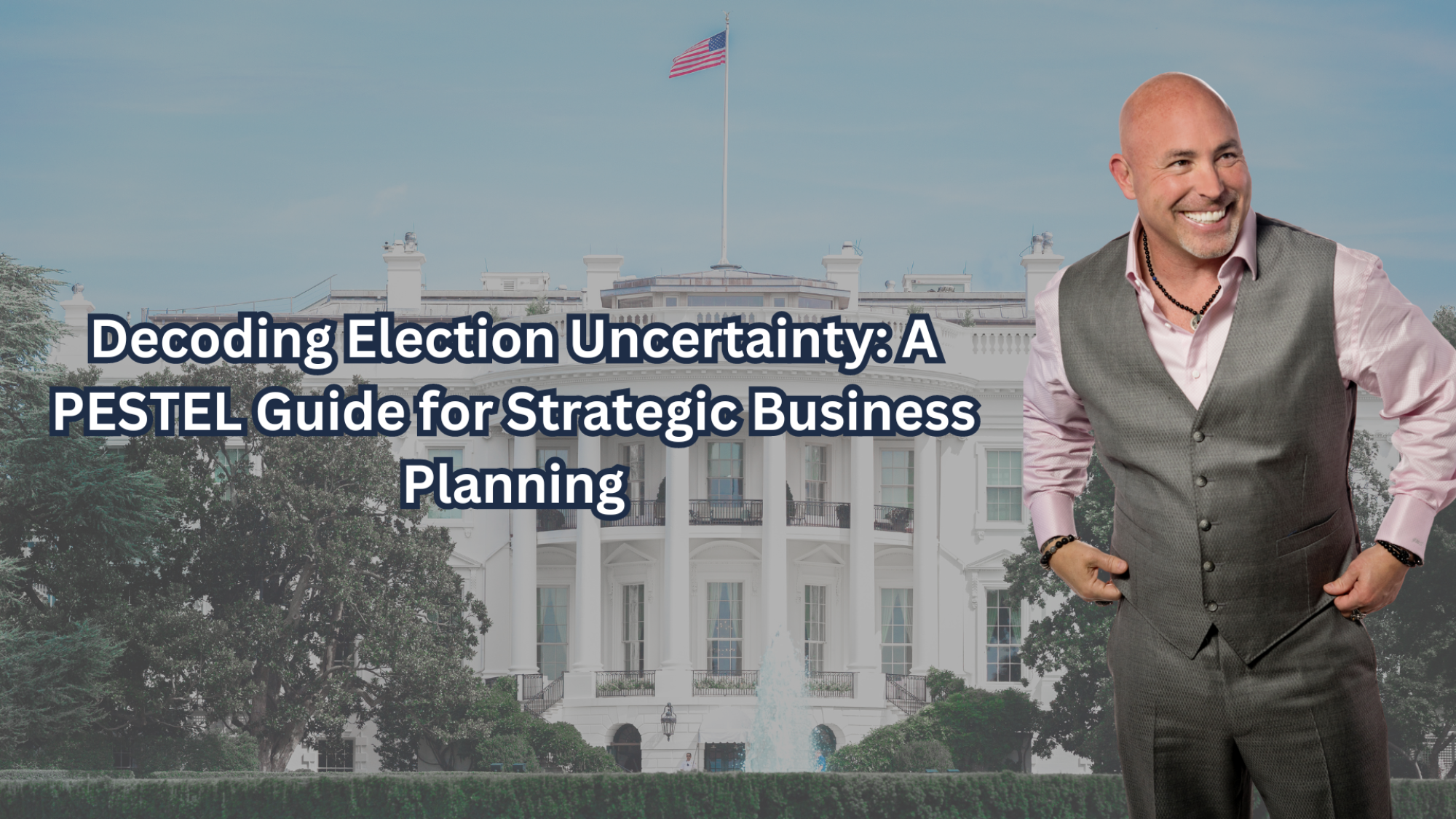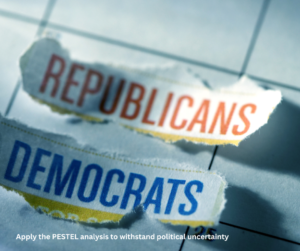
Decoding Political Uncertainty: The PESTEL Analysis
As we approach the upcoming election, businesses across the country are grappling with an atmosphere of political uncertainty. The potential for significant policy shifts, regulatory changes, and economic fluctuations looms large, leaving many leaders wondering how to prepare for the various possible outcomes.
In times like these, having a structured approach to analyzing the potential macro impacts of political change is crucial. This is where PESTEL analysis comes into play. PESTEL – which stands for Political, Economic, Social, Technological, Environmental, and Legal – offers a comprehensive framework for dissecting the complex web of factors that could affect your business in the wake of the election.
But how exactly can this analytical tool help your organization navigate the choppy waters of electoral uncertainty? In this post, we’ll explore how PESTEL analysis can be applied to the current political landscape, providing you with actionable insights to inform your strategic planning.
We’ll break down each component of PESTEL, showing you how to use this powerful tool to anticipate challenges, identify opportunities, and develop powerful strategies that can withstand the test of political change.
Whether you’re a small business owner, a corporate executive, or an entrepreneur, understanding how to leverage PESTEL analysis in the context of electoral uncertainty can give you a critical edge in these unpredictable times. So let’s dive in and discover how this versatile framework can help you turn political uncertainty into a strategic advantage.
Political Analysis
In the political sphere, our analysis begins with a close examination of the potential election outcomes. We’re not just looking at who might win, but what their victory could mean for the country’s direction. This involves a deep dive into the proposed policies of the candidates and parties. What are they promising? More importantly, what are they likely to deliver?
We must also consider the broader implications for governmental structure and leadership. Some elections bring about more than just a change of faces; they can herald significant shifts in how our government operates. This is particularly crucial when there’s potential for a change in the balance of power between different branches of government.
A key aspect of our political analysis focuses on the likelihood of policy shifts in critical areas. Taxation and regulation often take center stage here, as changes in these domains can have far-reaching effects on businesses and the economy at large. We need to ask ourselves: How likely are major tax reforms? Are we looking at potential regulatory overhauls in key industries?
By thoroughly examining these political factors, we can begin to paint a picture of the post-election landscape. This understanding forms the foundation for strategic decision-making, allowing businesses to prepare for a range of possible futures rather than being caught off guard by political developments.
Social Dynamics
In the social realm, our focus shifts to the ever-changing currents of public opinion.
What concerns are at the forefront of people’s minds? How are these concerns translating into political preferences? By understanding these dynamics, we can better anticipate potential election outcomes and their subsequent impact on social policies. This foresight is crucial for businesses that need to align their strategies with evolving social norms and expectations.
Technology and Innovation
The technological aspect of our analysis looks into the candidates’ stances on critical tech policies. We must consider the ripple effects on research and development funding. Will we see increased government investment in innovation, or a scaling back?
How might shifts in political power affect technology adoption rates or innovation incentives? These questions are particularly pertinent for businesses operating in tech-driven sectors or those undergoing digital transformation.
Environmental Considerations
Environmental policies have taken center stage in recent years, and their importance in our analysis cannot be overstated. We need to scrutinize the environmental platforms of the parties and candidates.
How might their proposed policies impact business operations, particularly in industries with significant environmental footprints?
Climate change policies and environmental regulations are likely to see substantial shifts depending on election outcomes. Energy policies, too, could undergo significant changes. Understanding these potential shifts is crucial for long-term strategic planning.
Legal Landscape
The legal component of our analysis focuses on potential changes to the regulatory environment. Different election outcomes could lead to varied approaches to business regulation. We need to consider possible reforms to the legal system and how these might affect day-to-day business operations.
Of particular interest are potential changes to contract law and intellectual property rights. These areas form the bedrock of many business interactions and innovations.
By anticipating potential legal shifts, businesses can better position themselves to adapt to new regulatory landscapes, minimizing risks and capitalizing on new opportunities.

Applying PESTEL in Uncertain Political Times
When utilizing the PESTEL framework during periods of electoral uncertainty, several key principles should guide our analysis:
- Scenario Planning: We must consider multiple potential outcomes, developing strategies that are robust across various political futures.
- Interconnected Analysis: It’s crucial to understand how changes in one area (e.g., political) might trigger shifts in another (e.g., economic). This holistic view allows for more comprehensive strategic planning.
- Continuous Updates: The political landscape can change rapidly. Regular updates to our analysis ensure we’re working with the most current information.
- Industry-Specific Focus: While maintaining a broad perspective, we must prioritize factors most relevant to our specific industry or business model.
By adhering to these principles, we can leverage the PESTEL framework to its fullest potential, turning political uncertainty into a strategic advantage.
Navigating the complexities of election uncertainty and its potential impacts on your business can be challenging.
While the PESTEL framework provides a solid structure for analysis, considering collaboration with a seasoned advisor can add significant value to your strategic planning process.
An experienced consultant or political risk analyst can offer deeper insights, challenge your assumptions, and help identify blind spots in your analysis. They can provide historical context, industry-specific knowledge, and a broader perspective on global trends that may influence domestic political outcomes. Additionally, an advisor can assist in translating your PESTEL analysis into actionable strategies, ensuring that your business not only weathers potential political shifts but is also positioned to capitalize on emerging opportunities.
This structured approach allows businesses to prepare for various outcomes, developing flexible strategies that can weather the storms of political change.
As we’ve explored, the PESTEL framework offers a powerful lens through which to view the complex landscape of electoral uncertainty. By methodically analyzing Political, Economic, Social, Technological, Environmental, and Legal factors, businesses can transform vague anxieties about the future into concrete, actionable strategies.
The goal isn’t to predict the future with perfect accuracy. The power of PESTEL lies in its ability to prepare your organization for a range of potential outcomes. This preparedness is what separates businesses that merely survive political transitions from those that thrive amidst change.
As you apply this framework to your own context, stay flexible and open-minded. The insights you gain may challenge your existing assumptions or reveal unexpected opportunities.
Embrace this process of discovery – it’s often at the point of fear and uncertainty that the best strategies emerge.